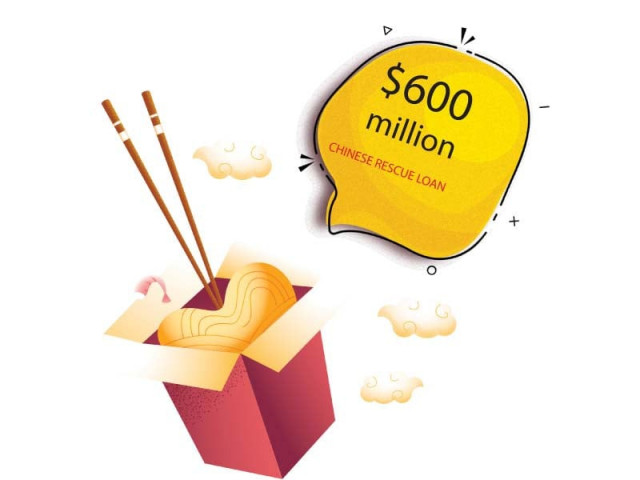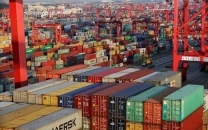Pakistan eyes $600m Chinese loans
Negotiations at advanced stage, financing may be released by next month

Pakistan has sought $600 million in fresh loans from two Chinese banks to bridge a big financing gap and also bets on successful completion of International Monetary Fund (IMF) talks for improvement in its credit rating to borrow from non-Chinese foreign banks.
Sources told The Express Tribune that the federal government was in negotiations with the Industrial and Commercial Bank of China (ICBC) and the Bank of China for a total loan of $600 million. Each bank has been approached for $300 million financing.
Negotiations are at an advanced stage and loans are expected to be received by next month, according to officials of the finance ministry.
Ministry of Finance spokesman Qamar Abbasi did not respond to questions sent to him.
Abbasi also did not respond to a query on whether Pakistan had sought another loan from the State Administration of Foreign Exchange (SAFE) of China. SAFE has already given $4 billion in loans that are rescheduled every year due to Pakistan’s inability to pay them back.
Diplomatic sources said that China and Pakistan were in close coordination to complete the remaining technical procedures for the loan of $600 million.
Read $72.7m in FDI received from China
In recent years, China has become Islamabad’s last hope for meeting emergency financing needs. Every government, including the caretakers, has reached out to China for rescue funds.
The Chinese have been extending loans from SAFE deposits, concessionary loans and commercial loans to help Pakistan to stabilise its external sector.
In June this year, China had helped Pakistan to avoid a further fall in its critically low foreign currency reserves by prematurely adjusting the repayment of $1.3 billion.
Sources said that interest rates on the new commercial facilities would be higher compared to the previous such arrangements due to a high global interest rate environment.
Pakistan has budgeted $4.5 billion in foreign commercial loans but it has so far not received any financing due to poor credit ratings, high risks to debt sustainability and a weak macroeconomic situation.
Since 2017, larger proportions of Chinese development finance have been rescue loans, rather than for developmental projects, which were the hallmark of CPEC in its heyday from 2014 to 2017 when fresh commitments were forthcoming in large amounts, wrote AidData, a western research lab, in its latest report.
Since 2000, China has given $21.2 billion in loans in general budget support, which was 30% of the total lending to Pakistan, according to AidData. These loans were taken to avoid default and push the low foreign currency reserves a bit higher.
The government has informed the IMF that its $6.5 billion borrowing plan hinges on the macroeconomic conditions.
Pakistani negotiators voiced hope that successful completion of the ongoing talks could give a boost to the country’s low credit ratings, which describe Pakistani debt as highly risky. Even if there is no immediate improvement in ratings, “we are hopeful that these agencies will upgrade the economic outlook on Pakistan,” said a senior Pakistani official on condition of anonymity.
After the staff-level agreement, Pakistani authorities plan to re-engage non-Chinese banks that have in the past given loans but are now reluctant due to the poor credit ratings and growing external sector risks.
Interim Finance Minister Dr Shamshad Akhtar had met with representatives of Standard Chartered Bank and Deutsche Bank and the international credit rating agencies on the sidelines of the IMF-World Bank meetings last month.
Read more ECC members oppose new benchmark loan rate
Three international credit rating agencies have downgraded Pakistan, which has increased its cost of borrowing and created obstacles in the way of arranging new foreign commercial loans.
Pakistan has also budgeted $1.5 billion in Eurobonds but its transaction will be subject to receiving a satisfactory health of economy certificate from the IMF. A stable global interest rate environment and improvement in Pakistan’s credit rating are the prerequisites for venturing into the world capital markets.
AidData reported that with 161 loans worth $69 billion, Pakistan has China’s third largest country-level loan portfolio anywhere in the world, after Russia and Venezuela.
All these loans have been extended on the request of Pakistani authorities.
Sources said that the IMF also discussed the issue of exchange rate management with the central bank. The IMF’s view was that there was a pattern first in rupee appreciation and then its deprecation during the past two weeks that indicated intervention in the market, said the sources.
Under the $3 billion deal, Pakistan has committed to the IMF to have a market-based exchange rate regime. Authorities had to intervene to curb smuggling and hoarding of the foreign currency, which led to a sequential reduction in the dollar value that slipped to Rs276 before appreciating again.
The rupee on Tuesday closed at around Rs286.40 to a dollar in the inter-bank market, losing Rs1.11 in a single day.
The central bank informed the IMF about progress on ending subsidies for export and other schemes and the capitalisation of two under-capitalised private commercial banks.
Published in The Express Tribune, November 8th, 2023.
Like Business on Facebook, follow @TribuneBiz on Twitter to stay informed and join in the conversation.


















COMMENTS
Comments are moderated and generally will be posted if they are on-topic and not abusive.
For more information, please see our Comments FAQ